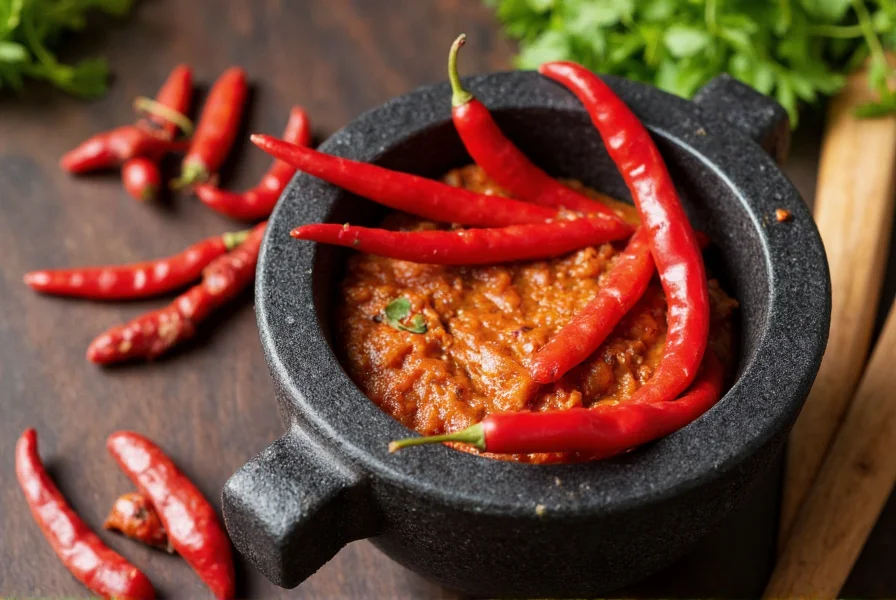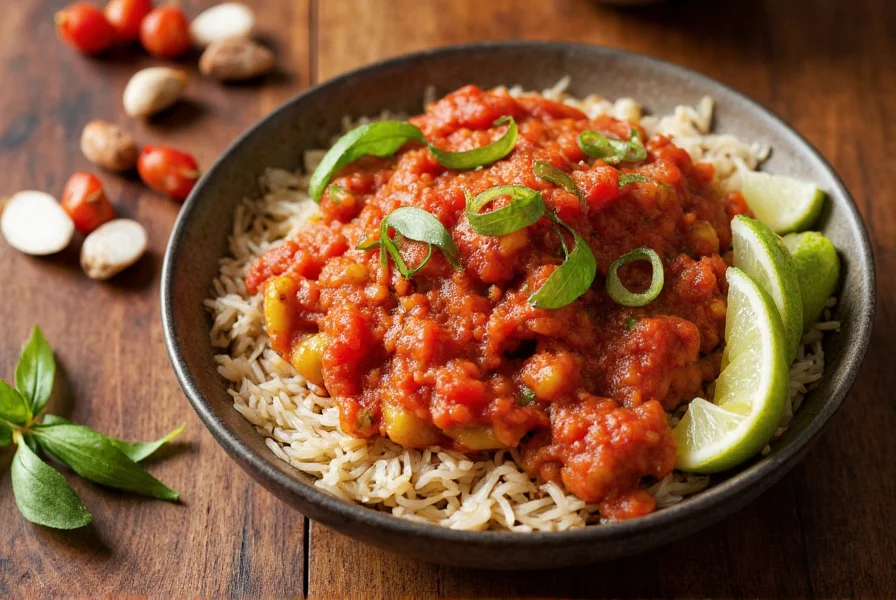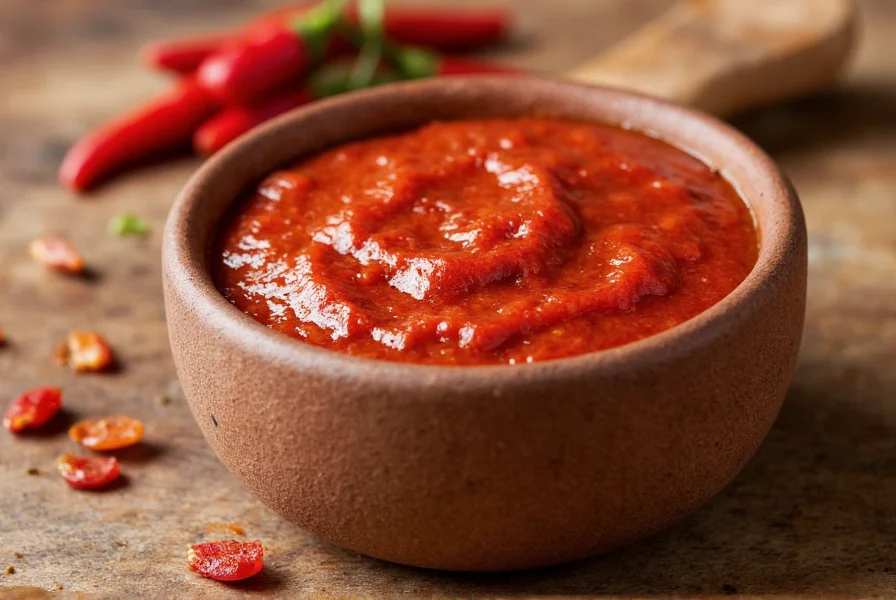Sambal oelek represents one of Indonesia's most essential culinary staples, with a history spanning centuries across the archipelago. The name itself reveals its nature: "sambal" refers to chili-based condiments in Indonesian, while "oelek" describes the traditional mortar-and-pestle preparation method. Understanding this foundational ingredient opens doors to authentic Southeast Asian cooking and flavor development.
Core Ingredients and Production Process
Authentic sambal oelek maintains remarkable simplicity in its composition. The traditional recipe includes only three components: fresh red chili peppers (typically cayenne or bird's eye chilies), vinegar, and salt. Some regional variations may include a small amount of sugar, but purists maintain that true sambal oelek contains no additional flavorings.
The production process significantly impacts quality. Traditional preparation involves grinding fresh chilies with salt using a cobek (Indonesian mortar) and ulekan (pestle), then adding vinegar to preserve the mixture. This manual method creates a textured paste with visible chili fragments, distinguishing it from smoother commercial alternatives. Modern production often uses mechanical grinders, but the best quality products maintain some texture rather than becoming completely homogenized.

Flavor Profile and Heat Characteristics
Sambal oelek delivers a clean, direct chili flavor without competing elements like garlic or fermented notes found in other hot sauces. Its heat registers between 25,000-50,000 Scoville Heat Units, placing it in the moderate range—significantly hotter than jalapeños but milder than habaneros. The vinegar content provides bright acidity that balances the heat, while the salt enhances overall flavor perception.
Unlike sriracha, which features garlic and sugar for a rounded profile, sambal oelek offers pure chili essence. This makes it particularly valuable when chefs want chili heat without additional flavor elements interfering with a dish's intended profile. The texture also contributes to its culinary function, as the visible chili pieces distribute heat more unevenly than smooth sauces, creating pockets of intensity throughout a dish.
Comparison with Similar Chili Products
| Product | Primary Ingredients | Heat Level | Texture | Best Culinary Uses |
|---|---|---|---|---|
| Sambal Oelek | Red chilies, vinegar, salt | Moderate (25k-50k SHU) | Coarse, visible chili pieces | Cooking base, finishing condiment |
| Sriracha | Chilies, garlic, sugar, vinegar | Mild-Moderate (1k-2.5k SHU) | Smooth, liquid | Dipping sauce, finishing touch |
| Gochujang | Fermented chilies, glutinous rice, soy | Moderate with sweetness | Thick paste | Marinades, stews, glazes |
| Tabasco | Tabasco peppers, vinegar, salt | Moderate-Hot (2.5k-5k SHU) | Liquid | Finishing sauce, cocktails |
Culinary Applications and Usage Tips
Understanding how to use sambal oelek properly distinguishes authentic Southeast Asian cooking from imitations. Professional chefs recommend adding sambal oelek early in the cooking process when building flavor foundations, as the vinegar cooks off while leaving the chili essence. For finishing touches, add it later to preserve its bright acidity.
When exploring sambal oelek in asian cuisine applications, consider these techniques:
- As a base for stir-fries: Add 1-2 tablespoons to hot oil before other ingredients
- In marinades: Combine with lime juice and fish sauce for proteins
- As a dipping sauce component: Mix with lime juice and palm sugar
- In soups and stews: Stir in during final minutes for fresh heat
- With eggs: Swirl into scrambled eggs or omelets
For those seeking sambal oelek substitute options, consider that no single alternative perfectly replicates its unique profile. A combination of red pepper flakes with rice vinegar offers the closest approximation, though with different texture. Pureed fresh chilies with vinegar provides another alternative when authentic sambal oelek isn't available.
Storage Recommendations and Shelf Life
Proper storage significantly impacts sambal oelek's longevity and flavor preservation. Commercial products typically remain stable at room temperature until opened, after which refrigeration becomes essential. Homemade versions require immediate refrigeration. When stored properly in airtight containers, quality sambal oelek maintains optimal flavor for 3-6 months in the refrigerator.
Freezing represents an excellent option for long-term storage of sambal oelek. Portion the paste into ice cube trays, then transfer the frozen cubes to freezer bags. This method preserves flavor for up to one year while allowing precise portioning for recipes. Always use clean utensils when handling to prevent contamination and premature spoilage.
Where to Purchase Authentic Sambal Oelek
Finding genuine sambal oelek requires attention to labeling and ingredients. The Huy Fong Foods brand (marketed as "Chili Garlic Sauce") is often mistaken for sambal oelek but contains garlic, making it unsuitable as a true substitute. Look for Indonesian brands like ABC, Indofood, or Mama Sita's that specifically label their product as "sambal oelek" without garlic in the ingredients.
Asian grocery stores typically offer the widest selection of authentic products at reasonable prices. When shopping online for where to buy authentic sambal oelek, check customer reviews mentioning the absence of garlic and the coarse texture. Specialty food retailers increasingly carry authentic versions as Southeast Asian cuisine gains popularity worldwide.
Nutritional Profile and Dietary Considerations
Sambal oelek remains one of the lowest-calorie flavor enhancers available, containing approximately 5-10 calories per tablespoon. Its primary nutritional components include capsaicin (the compound responsible for heat), vitamin C from fresh chilies, and minimal sodium from added salt. Those monitoring sodium intake should check labels, as salt content varies between brands.
The capsaicin in sambal oelek offers potential health benefits including metabolism boost, pain relief properties, and anti-inflammatory effects. However, these benefits require regular consumption as part of a balanced diet rather than isolated use. Individuals with gastrointestinal sensitivities should moderate their intake due to the potential for irritation.

Frequently Asked Questions
What's the difference between sambal oelek and sriracha?
Sambal oelek contains only chilies, vinegar, and salt with no garlic, while sriracha includes garlic, sugar, and a smoother texture. Sambal oelek delivers pure chili heat (25k-50k SHU) compared to sriracha's milder, sweeter profile (1k-2.5k SHU). The texture differs significantly, with sambal oelek maintaining visible chili pieces.
Can I make sambal oelek at home?
Yes, homemade sambal oelek preparation requires fresh red chilies (cayenne or bird's eye), vinegar, and salt. Blend 1 cup chilies with 2 tablespoons vinegar and 1 teaspoon salt until coarse. Traditional preparation uses a mortar and pestle for optimal texture. Store in the refrigerator for up to 3 weeks or freeze for longer preservation.
Why doesn't my sambal oelek taste like restaurant versions?
Many commercial products labeled as sambal oelek actually contain garlic, making them unsuitable substitutes. Check ingredients for garlic, which authentic sambal oelek lacks. Restaurant versions often use freshly made sambal with optimal chili ripeness. For closest results, seek Indonesian brands like ABC or Mama Sita's that maintain traditional recipes without added garlic.
How spicy is sambal oelek compared to other hot sauces?
Sambal oelek registers between 25,000-50,000 Scoville Heat Units, placing it significantly hotter than sriracha (1,000-2,500 SHU) and Tabasco (2,500-5,000 SHU), but milder than habanero-based sauces (100,000-350,000 SHU). Its heat feels cleaner and more direct than fermented sauces like gochujang, with immediate impact rather than building intensity.
Does sambal oelek need refrigeration after opening?
Yes, refrigeration is essential after opening to maintain freshness and prevent spoilage. Commercial sambal oelek remains stable at room temperature before opening due to vinegar preservation, but once exposed to air and potential contaminants, refrigeration extends its shelf life to 3-6 months. Always use clean utensils when serving to maximize longevity.











 浙公网安备
33010002000092号
浙公网安备
33010002000092号 浙B2-20120091-4
浙B2-20120091-4